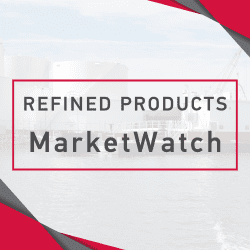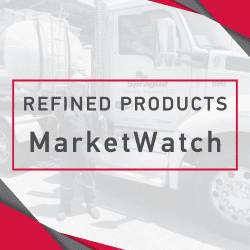Recap: After rising to 3-year highs, oil prices are beginning to show signs of weakening, as investors exit record length and U.S. production continues to strengthen. Prices may very likely be in a corrective phase, as it appears that price movement has gotten ahead of the true underlying fundamentals of this market. Tuesday marked the second straight session of losses, with March WTI falling $1.06, or 1.62%, to settle at $64.50 a barrel, while the soon to expire March Brent settled at $69.02 a barrel, down 44 cents, or .63%.
March RBOB fell 4.8 cents, or 2.5%, to $1.87 a gallon, while March heating oil lost about 3 cents, or 1.4%, to $2.07 a gallon.
Fundamental News: cFlow, S&P Global Platts trade flow software, reported that gasoline flows to the US and east coast of Canada from Northwest Europe set to arrive in February amount to about 217,000 metric tons so far. For January arrivals, the total volumes of gasoline exports from NEW and the Baltics to North America is set to reach about 578,000 metric tons, marginally higher than the 557,000 metric tons recorded in December.
According to data from the S&P Global Platts Analytics and US Customs, 5.49 million barrels of Iraqi Basrah Light crude was imported through the Louisiana Offshore Oil Port. It's up 1.98 million barrels from December and up 1.08 million barrels from January 2017. The increase in imports comes following continued cuts to Basrah Light and Basrah Heavy official selling prices for the US.
Exxon Mobil said it is tripling its daily oil and natural gas production in the Permian Basin to more than 600,000 barrels of oil equivalent by 2025. It is also spending more than $2 billion to upgrade its transportation infrastructure in West Texas and New Mexico. It said the tax law has created an environment for increased future capital but these investments are also largely being driven by rising oil prices. It stated that the increase in production will result from a reduction in drilling cots, technology improvements and expanded acreage.
Crude oil production from Libya’s Elephant or El-Fil, oil field, fell from about 74,000 bpd on Thursday to zero on Friday, before increasing to about 25,000 bpd on Saturday. There was no reason given for the sharp decline in production.
The head of Libya’s National Oil Corp, Mustafa Sanalla, said the country’s ability to rebuild its oil output will be hindered by ongoing constraints on National Oil Corp’s budget. He said NOC received only 50% of its capital expenditure budget from the Libyan government in 2017.
US shale producers are facing rising costs for everything from drilling rigs to pressure pumping equipment and labor. According to the US Bureau of Labor Statistics, the cost of drilling oil and gas wells has increased significantly over the last year. Drilling costs increased by more than 10% since hitting a cyclical low in November 2016, though they are still 27% below the cyclical peak set in March 2014.
US Environmental Protection Agency Administrator, Scott Pruitt, said that the agency hopes to decide soon whether it has the legal authority to issue a national waiver on the selling of gasoline containing 15% ethanol during summer months.
Early Market Call – as of 9:00 AM EDT
WTI – Mar $64.31, down 20 cents
RBOB – Feb $1.8571, down 1.31 cents
HO – Feb $2.0649, down 22 points
View the Sprague Refined Products Market Watch Report in a downloadable pdf format by clicking below.
Click to view more online:
View market updates
View our refined products glossary
Go to SpraguePORT online









